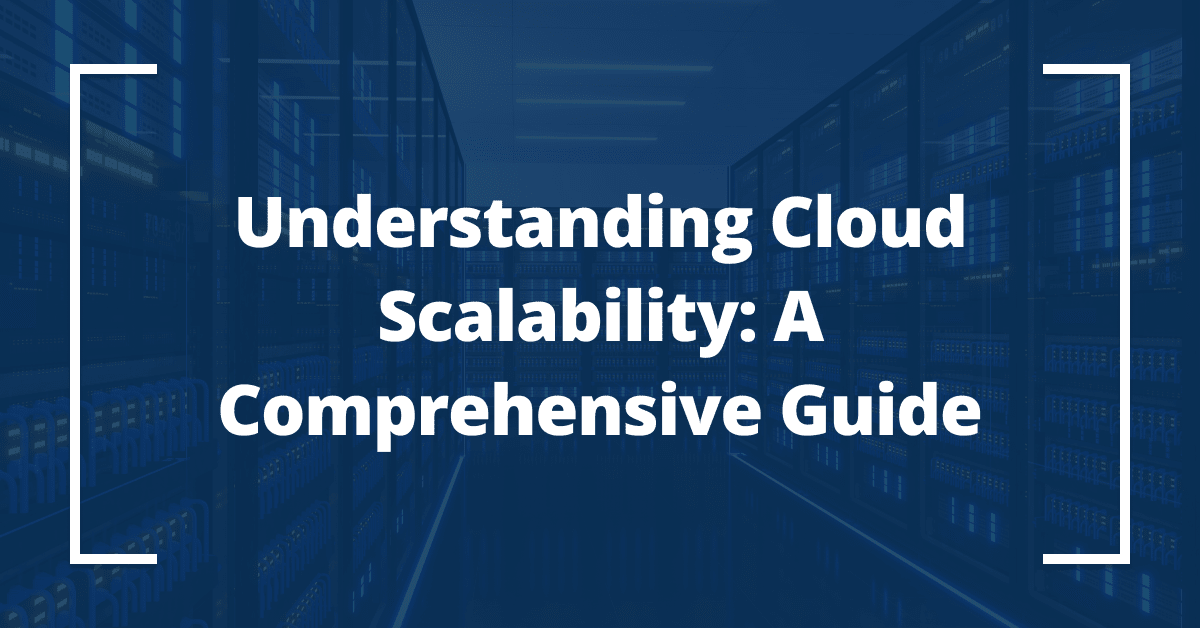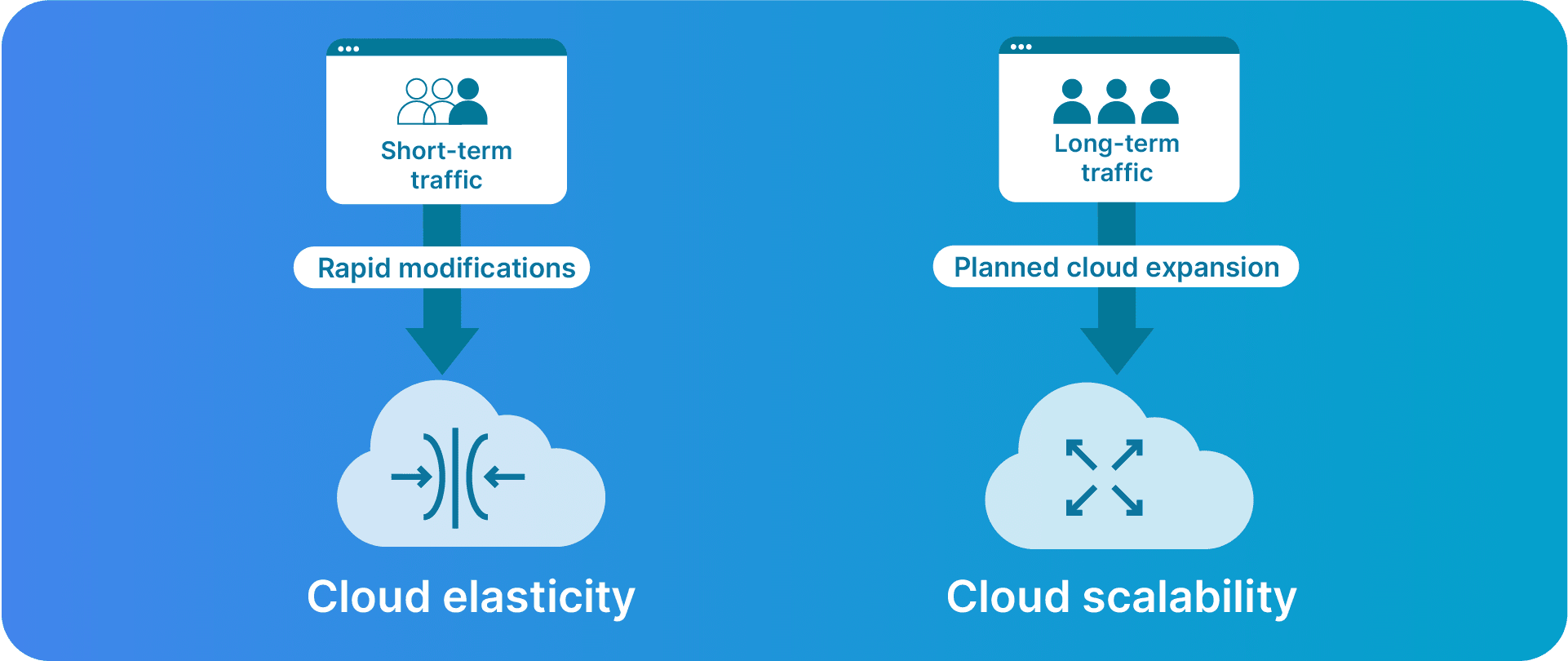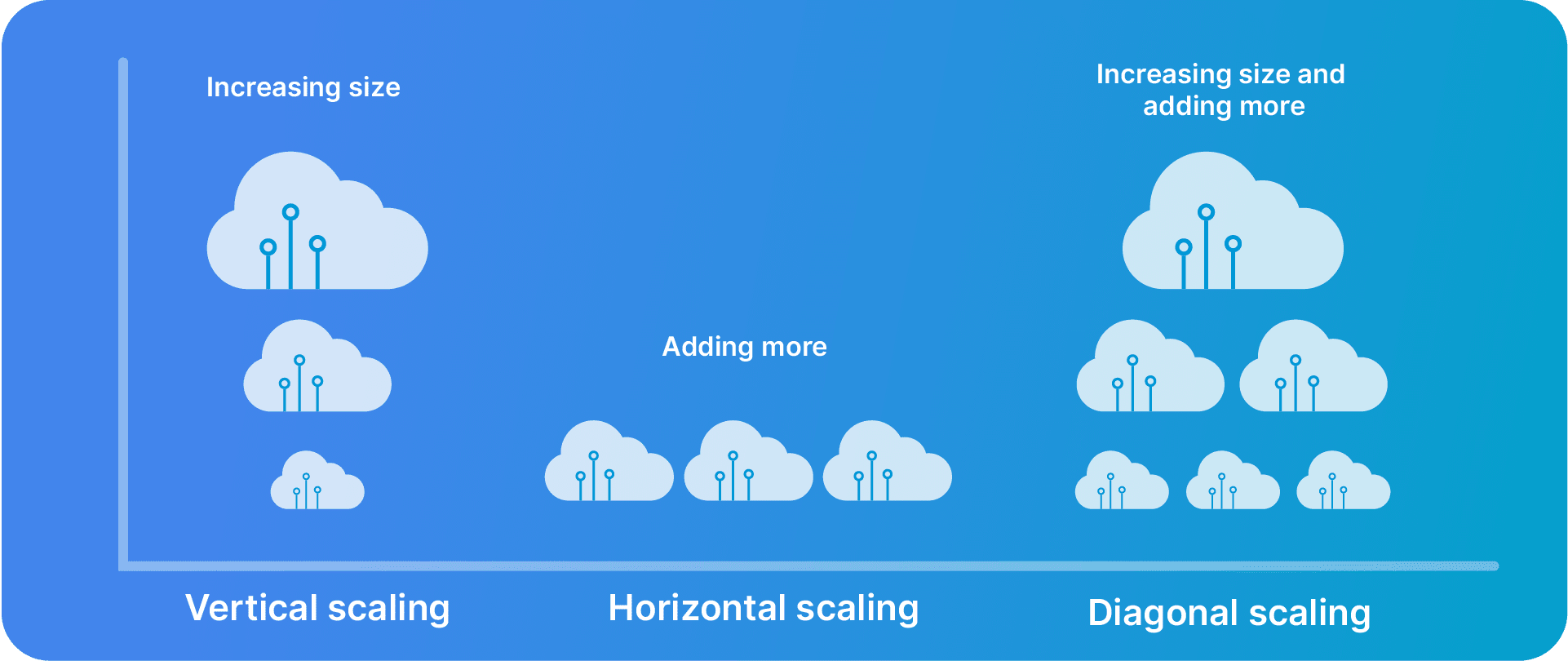
[ad_1]
Today’s fast-paced market requires businesses to continually adapt to shifting customer demands and technological advancements to remain competitive. Tailoring cloud resources holds the key to enhancing your business’s overall performance and efficiency.
Enter cloud scalability – a game-changing solution that empowers organizations to expand or contract their IT infrastructure in response to demand fluctuations.
This guide will demystify the concept of cloud scalability and its various forms. By the time you’ve finished reading, you’ll be able to identify and employ the cloud scalability strategy that best aligns with your business requirements.
Demystifying cloud scalability: An introduction
Cloud scalability refers to the ability of a cloud-based system to seamlessly accommodate an increasing workload without sacrificing performance, stability, or cost-effectiveness. In simpler terms, it is the engine that propels your digital infrastructure to effortlessly adapt to the ebb and flow of demand, ensuring that you always have the right amount of resources precisely when you need them.
The significance of cloud scalability transcends mere convenience; it is the cornerstone upon which modern business resilience and success are built.
The two primary facets that enable companies to harness these advantages are elasticity and scalability, both of which are key to optimizing your cloud infrastructure for success. But what is the difference between these essential concepts?
Elasticity vs scalability: A comparative analysis

While both elasticity and scalability revolve around resource adjustment, they serve unique roles.
Cloud elasticity caters to short-term, rapid modifications to adjust to changing demands just like an elastic band adapting to different lengths without breaking. For instance, businesses facing unexpected traffic surges would utilize elasticity to maintain optimal performance.
On the other hand, scalability focuses on long-term, planned expansion, enabling a system to handle sustained workload increases. For example, scalability comes to the forefront when businesses anticipate consistent growth in user demand or are planning operational expansion.
To sum it up, here’s a side-by-side comparison:
| Elasticity | Scalability | |
|---|---|---|
| Response time | Offers rapid response to immediate changes in demand, ensuring that your system can handle unexpected surges. | Requires a more deliberate approach, making it suitable for long-term growth planning. |
| Cost efficiency | Can lead to cost savings during off-peak periods by scaling down resources. | Focuses on cost management over the long haul by preventing overprovisioning or underprovisioning. |
| Complexity | Often involves the use of auto-scaling features provided by cloud service providers, which simplifies resource management. | Requires careful design and architecture planning. |
| Use cases | Ideal for applications with variable workloads. | Suits businesses with predictable, steady growth. |
Both strategies underpin the overarching objective of maintaining uninterrupted performance regardless of demand fluctuations.
Exploring the types of cloud scalability: Vertical, horizontal, and diagonal
As businesses increasingly migrate their operations to the cloud, understanding the nuances of cloud scaling approaches – vertical, horizontal, diagonal – becomes more critical than ever. Each type of scaling has its unique strengths and considerations, making it essential for decision-makers to tread cautiously and choose the strategy that aligns seamlessly with their business objectives.

Vertical scaling
Commonly referred to as “scaling up”, vertical scaling involves increasing the capacity of a single existing server by:
- Adding more CPU cores for superior processing power.
- Increasing the RAM for improved system performance.
- Upgrading the storage capacity with larger drives to accommodate more data.
- Enhancing the GPU for graphics-intensive tasks.
- Amplifying network bandwidth for faster data transmission.
This scalability method is well-suited for applications with a linear performance pattern, where adding more power to a single resource can effectively handle increased demands. However, there are limitations to vertical scaling, as it may eventually reach a point where further enhancements become too expensive or technologically unfeasible.
Horizontal scaling
Horizontal scaling, or “scaling out”, takes a different approach. It tackles increased workloads by adding more servers to the system, which involves:
- Developing a larger server pool for expanded capacity.
- Evenly distributing tasks across several servers.
- Scaling out to handle higher user loads.
- Improving fault tolerance by ensuring server redundancy.
While horizontal scaling can be a bit more complex than vertical scaling, it offers impressive scalability and resilience owing to the distributed setup. It can also enhance fault tolerance, as the workload can be distributed, reducing the risk of a single point of failure.
This approach aligns well with cloud-native architectures and microservices, where modular components can be easily replicated.
Diagonal scaling
Diagonal scaling, also known as auto-scaling, involves both increasing the capacity of individual resources (vertical scaling) and adding more resources (horizontal scaling) to your cloud setup. By implementing diagonal scaling, businesses can:
- Optimize the performance of existing resources.
- Ensure flexibility and fault tolerance through resource expansion.
- Combine resource allocation with server redundancy to achieve scalability.
This approach can be the ideal option for applications with complex and evolving requirements, providing the versatility needed to address diverse demands effectively.
Here is a quick evaluation of the pros and cons of each method:
| Pros | Cons | |
|---|---|---|
| Vertical scalability | Simple, cost-effective, and straightforward to execute without significant architectural changes. | May hit limits as your business grows. |
| Horizontal scalability | Provides flexibility and redundancy to manage enormous workloads. | Requires careful design and management of the cloud infrastructure. It may also involve higher initial costs due to the need for multiple virtual instances or containers. |
| Diagonal scalability | A balanced solution that allows for the optimization of existing resources while adding new ones for increased adaptability and fault tolerance. | Complex to implement. |
Choosing the right type of cloud scaling for your business
To make the decision process easier, consider the following key factors:
- Workload characteristics: Analyze your workload’s behavior. Is it sporadic, with unpredictable spikes in demand, or does it require constant, high-performance resources?
- Cost constraints: Assess your budget limitations. Vertical scaling may be cost-effective for small to moderate growth, while auto-scaling is suitable for dynamic, variable workloads.
- Application compatibility: Determine if your applications support horizontal scaling. Legacy or monolithic applications may be better suited for vertical scaling.
- Resource management: Gauge the level of control and management you require. Auto-scaling provides automated resource management, while manual intervention is more prevalent in vertical and horizontal scaling.
By selecting the right cloud scalability approach, businesses can position themselves to thrive in the face of evolving demands and emerging opportunities in the cloud era.
For businesses seeking a hassle-free approach to cloud scaling, Liquid Web’s fully managed hosting service offers a compelling solution. It takes the burden of server maintenance and management off your shoulders. This way, you can stay focused on what matters most: achieving your business objectives.
Unleashing the power of cloud scalability: Key benefits
Embracing the power of cloud scalability offers diverse benefits for businesses of all sizes and industries, like:
- Cost optimization: In the pursuit of cost efficiency, cloud scalability is your ally. It empowers organizations to align their infrastructure costs with actual usage, avoiding the pitfalls of over-provisioning and thus reducing unnecessary expenditures.
- Improved performance: Scalable cloud resources ensure that your systems deliver peak performance even during unexpected traffic spikes, resulting in superior user experiences, reduced latency, and heightened customer satisfaction. Liquid Web’s high-performance hosting service does that and more.
- Business agility: Businesses can easily respond to market changes, launch new products or services, and experiment without fearing colossal financial or operational risks.
- High availability and uptime: Scalable cloud architectures enhance reliability through resource redundancy, distributing workloads across multiple servers or regions. This robustness minimizes the risk of downtime due to hardware failures or other unforeseen issues, safeguarding your business continuity. Organizations can harness this advantage through Liquid Web’s high-availability hosting.
- Global reach: The world is your market, and cloud scalability enables you to conquer it without establishing physical infrastructure in every corner of the globe. Leading cloud providers, such as Liquid Web, offer data centers in various regions, facilitating your global expansion endeavors.
Although cloud scaling provides these valuable advantages, it is not without its difficulties.
Navigating the challenges in cloud scalability
It’s equally essential to acknowledge the challenges associated with adopting cloud scalability. These obstacles, if not addressed, can lead to inefficiencies, significant cost implications, and security vulnerabilities.
Technical complexity
Scaling in the cloud is a complex process that requires more than just pouring additional resources into your server. It involves a deep understanding of infrastructure layouts, data flows, application needs, and network constraints.
For example, businesses might need to manage processes as complicated as setting up load balancers or configuring security groups. Smaller businesses, startups, or organizations without a dedicated IT team might find it challenging to handle these complexities.
Security concerns
Cloud scalability also introduces new dimensions of security concerns. As businesses significantly increase their systems’ interconnectivity, they sometimes inadvertently open up avenues for potential security breaches.
These could be as severe as unauthorized system access, data breaches, or Distributed Denial-of-Service (DDoS) attacks, which underscores the need for vigorous and proactive security measures.
Cost implications
Even though cloud scalability is cost-effective in the long run, the initial transition from a traditional infrastructure to a scalable cloud model can be expensive. Calculating the costs involved in cloud scalability is a complex process that goes beyond simple arithmetic.
Considerations like storage management, network resources, and server efficiency all come into play. For instance, businesses might need to invest in training, new hardware, or more expensive software plans that can accommodate scaling. Therefore, it’s crucial for businesses to factor in these elements when budgeting for cloud scaling.
Fortunately, these difficulties are not insurmountable with the right resources and a great web hosting provider, which is where Liquid Web shines.
Liquid Web’s 24/7/365 human support can provide the expert guidance and services required for this endeavor. With a keen understanding of the cloud scaling landscape, Liquid Web’s support team is well-positioned to assist businesses in facing every technical complexity, providing security solutions, mastering cost implications, or any other challenges that cloud scalability presents. Their expertise covers areas like hands-on troubleshooting, customizing scalable plans, and implementing proper security measures to ensure that businesses achieve a smooth and effective scaling process.
Achieving and optimizing cloud scalability: A step-by-step guide
By following this step-by-step tutorial, you’ll be able to bolster your organization for agility to thrive in today’s dynamic business environment.
Step 1. Assess your current infrastructure
Understanding your current setup is essential for making informed decisions about scaling in the cloud.
- Take stock of your current IT assets, software applications, and data storage requirements.
- Identify any bottlenecks or performance issues that need to be addressed.
Step 2. Set clear objectives
Define your scalability goals and establish clear objectives to fine-tune your cloud scalability strategy and measure success. Ask yourself: are you looking to handle increased user traffic, accommodate seasonal fluctuations, or improve system reliability?
Step 3. Choose the right cloud scalability model
To choose the right cloud scalability model for your business, carefully assess your requirements. Consider factors such as your growth projections, budget constraints, application architecture, and the level of control you need.
Whether you opt for vertical scalability, horizontal scalability, or diagonal scalability, the key is to:
- Align your choice with your business goals and IT strategy.
- Implement best practices like microservices architecture and containerization.
- Utilize load-balancing services provided by your cloud provider (i.e., Liquid Web’s load-balancing solution) to optimize resource utilization and enhance system reliability.
- Plan for disaster recovery by creating redundant resources in different geographic regions to ensure high availability and minimize downtime in the event of system failures or disasters.
- Incorporate automation tools to dynamically allocate resources according to your scaling policy using auto-scaling features provided by cloud service providers or dedicated third-party tools.
Step 4. Monitor performance
Continuous monitoring is essential to identify performance bottlenecks and optimize resource allocation. Implement monitoring tools and establish key performance metrics. Regularly review and adjust your cloud resources to maintain optimal performance.
Liquid Web has several performance add-ons and monitoring tools that can be especially useful here.
Achieving and optimizing cloud scalability with Liquid Web
Even though cloud scalability can appear challenging, Liquid Web can be your trusted ally. Liquid Web’s VMware private cloud and enterprise hosting solutions stand as essential resources in this regard, providing businesses the freedom to scale efficiently while maintaining cost-effectiveness.
The VMware private cloud is notably recognized for its flexibility, chiefly its transparent pricing model. Businesses gain the power to manage multiple projects without concern for hidden costs or per-VM charges.
Additionally, Liquid Web’s enterprise hosting solutions are tailored precisely to adapt to organizations’ needs. Whether it is a high-traffic eCommerce platform seeking to optimize user experience, or a growing corporation needing to increase computational capacity, Liquid Web has the ideal solution for your company.
Real-world applications of cloud scalability: Case studies
If it’s not clear already, here is a deeper exploration of case studies to provide tangible evidence of the importance of scalable cloud computing for businesses of varying sizes and sectors:
Home Depot
When Home Depot sought integration with U.S. Home Systems, they needed to keep their online store functioning optimally during traffic spikes. Liquid Web’s scalable solution, integrating dedicated servers and Cloud VPS, achieved this.
As a result, Home Depot’s site performance improved by 37%, enhancing its user experience while saving on infrastructure costs.
PistonBroke
Liquid Web’s scalable hosting infrastructure ensured enduring responsiveness, even during surges, effectively catering to diverse client needs.
AmpleHarvest
Upon facing hosting issues due to unexpected traffic spikes, AmpleHarvest, a non-profit organization, shifted to Liquid Web’s cloud VPS hosting solution. They were, therefore, able to successfully manage traffic spikes, reporting a 99.9% uptime and a significant advancement in their protection against cyber threats.
Each of these cases attests to the positive impact and benefits of cloud scalability, irrespective of the size of the business or industry. Compared to various other service providers, Liquid Web consistently demonstrates its distinct expertise by offering scalable solutions tailored to the technical and financial needs of businesses.
Leveraging Liquid Web’s managed hosting for optimal cloud scalability
Having navigated your way through the world of cloud scalability, you now understand its critical concepts, varied forms, and implementation strategies. Having a scalable cloud infrastructure allows growth, flexibility, efficiency, and exceptional adaptability in the face of altering market shifts.
To bypass the technical complexities of implementing scalable solutions, consider opting for managed hosting.
Liquid Web’s managed hosting services guide businesses to harness the power of cloud scalability safely. You won’t need to worry about potential downtime or cost implications. Liquid Web’s uptime guarantee and transparent pricing model provide a smooth-sailing cloud environment.
Adopting scalable cloud resources doesn’t have to be an uphill battle. With the right partner, your business can smoothly transition to and optimize cloud scalability.
Ready to make the leap? Contact Liquid Web today and leverage the expertise and resources needed to elevate your business to new heights!
[ad_2]
Source link






